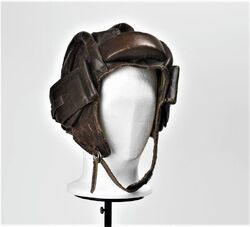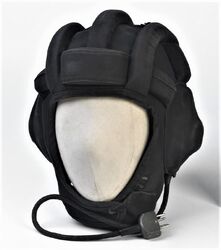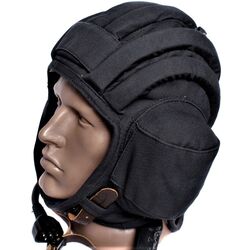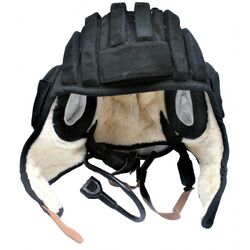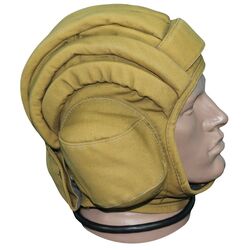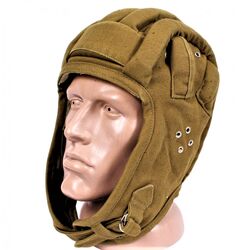mNo edit summary Tag: Visual edit |
(Provided another reference.) Tag: Visual edit |
||
| Line 44: | Line 44: | ||
As also previously mentioned, this variant made an introduction of the summer model, designated as ''ТШ-4М-Л'' (TSh-4M-L), which lacks the common [[Wikipedia:Fur clothing|fur]] (or eventually [[Wikipedia:Wool|wool]]) internal lining. Many of these summer versions were made in [[Wikipedia:Khaki|''Khaki'']] pattern<ref>https://www.soviet-power.com/image/cache/data/2019/24122019%20-%20Helmet%202-1000x1000.jpg</ref>, mainly intended for Soviet tankers involved in [[Wikipedia:Soviet-Afghan war|Intervention in Afghanistan]], but most were still made black colored, in order to match and accommodate to the classic Soviet army black canvas tanker's coverall, known as Танковый костюм (''Tankovij kostjum''/[[Tankoviy kostyum]], literally; ''Tanker's costume''), which was used almost until the end of USSR and always paired with this helmet. |
As also previously mentioned, this variant made an introduction of the summer model, designated as ''ТШ-4М-Л'' (TSh-4M-L), which lacks the common [[Wikipedia:Fur clothing|fur]] (or eventually [[Wikipedia:Wool|wool]]) internal lining. Many of these summer versions were made in [[Wikipedia:Khaki|''Khaki'']] pattern<ref>https://www.soviet-power.com/image/cache/data/2019/24122019%20-%20Helmet%202-1000x1000.jpg</ref>, mainly intended for Soviet tankers involved in [[Wikipedia:Soviet-Afghan war|Intervention in Afghanistan]], but most were still made black colored, in order to match and accommodate to the classic Soviet army black canvas tanker's coverall, known as Танковый костюм (''Tankovij kostjum''/[[Tankoviy kostyum]], literally; ''Tanker's costume''), which was used almost until the end of USSR and always paired with this helmet. |
||
| − | The TSh-4M directly served as a basis for Soviet paratrooper helmet, known as ДШ (DŠ/DSh, meaning ''Desantnij Šlem''/''Desantniy Shlem, ''translated as; Airborne helmet), also popularly called Прыжковый шлем (Prižkovij šlem/Prizhkoviy shlem - Jump helmet). It was developed directly from TSh-4M and made its first appearance among [https://en.wikipedia.org/wiki/Russian_Airborne_Forces Soviet paratroopers] during late 1970s. It was literally just a standard TSh-4M helmet with only distinctive ear coverings removed (due to having its headset removed) and replaced with airholes on each side. Also, in contrast to the original TSh-4M, it was produced mainly in cotton instead of the usual canvas and did not feature standard black but ''Khaki'' appearance instead. |
+ | The TSh-4M directly served as a basis for Soviet paratrooper helmet, known as ДШ (DŠ/DSh, meaning ''Desantnij Šlem''/''Desantniy Shlem, ''translated as; Airborne helmet), also popularly called Прыжковый шлем (Prižkovij šlem/Prizhkoviy shlem - Jump helmet). It was developed directly from TSh-4M and made its first appearance among [https://en.wikipedia.org/wiki/Russian_Airborne_Forces Soviet paratroopers] during late 1970s. It was literally just a standard TSh-4M helmet with only distinctive ear coverings removed (due to having its headset removed) and replaced with airholes on each side. Also, in contrast to the original TSh-4M, it was produced mainly in cotton instead of the usual canvas and did not feature standard black but ''Khaki'' appearance instead (current Russian army versions are being produced in newest ''EMR'' digital pattern camouflage).<ref>https://scontent.fzag1-1.fna.fbcdn.net/v/t1.0-0/p640x640/116115888_2703818759860863_7260439202389574130_o.jpg?_nc_cat=101&_nc_sid=8024bb&_nc_ohc=Ukh5Ymp4wT0AX8St2lA&_nc_ht=scontent.fzag1-1.fna&_nc_tp=6&oh=e56db8d4100f5f2f58344fdaecbbd4d8&oe=5F5195E5</ref> |
At the end of 1980s, slightly before the breakup of the Soviet Union and dissolution of the Soviet army along with it, the existing TSh-4M helmet was only marginally updated and received just a few trivial, but still very easily noticeable changes. Apart from being equipped with newer and more modern radio set (microphone and plug) due to which it has larger (more bulged out) ear covers, it also received a slight redesign by now featuring six instead of the usual four bulged longitudinal, protective lines on the overhead, as found in the previous model. However, due to all these changes being trivial and just a slighter modifications of the existing helmet, it retained its previous designation, the TSh-4M or TSh-4M-L, for the summer variant. |
At the end of 1980s, slightly before the breakup of the Soviet Union and dissolution of the Soviet army along with it, the existing TSh-4M helmet was only marginally updated and received just a few trivial, but still very easily noticeable changes. Apart from being equipped with newer and more modern radio set (microphone and plug) due to which it has larger (more bulged out) ear covers, it also received a slight redesign by now featuring six instead of the usual four bulged longitudinal, protective lines on the overhead, as found in the previous model. However, due to all these changes being trivial and just a slighter modifications of the existing helmet, it retained its previous designation, the TSh-4M or TSh-4M-L, for the summer variant. |
||
Revision as of 10:01, 5 August 2020
The TSh-4 or TŠ-4 (ТШ-4, meaning; Танковый шлем; translated from Cyrillics to Latin as Tankovij šlem, to English alphabet as Tankoviy shlem and simply meaning; Tanker's helmet), alternatively known either as Танкошлем (Tankošlem/Tankoshlem - same meaning, but shortened), or somewhat inaccurately as Шлемофон (Šlemofon/Shlemophone and loosely translated as Headset, since any helmet with built-in radio could be referred to as being such) is once Soviet and today primarily Russian tank crew's famous combat helmet, an indispensable headwear of literally any combat vehicle operator, a well known and probably the main recognition symbol (a trademark) of all Soviet, Eastern bloc, Warsaw pact and today post-Soviet tank crews as well as of literally anyone else using any kind of Soviet armor and their combat vehicles in general.
The earliest model, originally designated ТШ-4, made its first appearance back in interwar period (during late 1920s), when then Soviet Red army started to equip itself with their first armored vehicles (tanks) and was continued to be produced through World War II up until the end of 1940s and beginning early Cold War period. Then, it was replaced with a severely redesigned and modernized model in then recently renamed Soviet army, now designated as ТШ-4М (М standing for Modernizirovannij/Modernizirovanniy, simply meaning Modernized) which was continued to be produced through almost the entire Cold war era and end of 1980s, when it was, after the breakup of USSR, completely replaced with only slightly redesigned and still current model used by Russian army, which, however, retained the same (ТШ-4М) designation.
Among enthusiasts and collectors, the early/first model (ТШ-4) is nowadays colloquially known as either Red army or somewhat incorrectly as WWII model (since it appeared almost twenty years before the outbreak of the war), the second and the most widespread, popular and well known model, the ТШ-4М is known either as the Cold war or Soviet army model, while the latest one is commonly known as Russian army or as the Modern model.
The second model (ТШ-4М), had also made introduction of the summer variant, which is designated as ТШ-4М-Л (TSh-4M-L). The capital letter Л (L) stands for Летний; Letnij/Letniy, meaning Summer), due to which it lacks the usual fur lining inside.
Some TSh-4 models even featured a standard metallic Red star nailed directly on their forehead-protective part, which is very rarely found even in the modernized, TSh-4M. They were also occasionally paired with standard Soviet tanker's googles, [1] a practice which was later officially dropped, during the Cold war era.
As mentioned in the very beginning, this helmet was copied literally far and wide through the world by anyone using any kind of Soviet combat vehicles, due to which it is even today, over ninety years after its first introduction, still very well known piece of equipment and is also relatively easy to acquire. In the English speaking world, it is known simply as the Soviet tank helmet, alternatively as the Soviet tanker helmet or rarely, as the Soviet tank cap.
TSh-4

3D model featuring standard appearance of Red army tankers during World War II, wearing their distinctive one-piece-black canvas coverall, older model of popular Sapogi jackboots and using TSh-4 helmet. Commanders (officers) were issued with TT pistol, while regular tankers (gunners, loaders and drivers) were commonly armed with sub-machine guns, either PPD, PPS or PPŠ.
As mentioned back during introduction section, the first and the earliest variant of the Soviet tank helmet appeared back in the end of 1920s, when the Soviet Red army started acquiring its first tanks (most notably the T-18, T-24 and then T-26 as well as famous BT series of light tanks). This TSh-4 is easily distinguished from the later and much more common models (TSh-4M), since it was severely different in its design. Firstly, it was also made out of genuine (calfskin) black-coated (or even brownish) leather, instead exclusively from canvas, as the later (TSh-4M) models, although the later variants (starting from 1940s) already switched to canvas. This was due to the fact that first Red army tank crews coveralls were originally made out of same black-coated (fire resistant) leather (the ones from early 1930s) but were already during 1940s switched to the common canvas materials (retaining black color), these helmets along with them.
By the sole design, this model is nowadays fairly easily distinguished compared to the latter ones, firstly by only three severely divided vertical (longitudinal) lines on its overhead part (filled withfoam sponge which served for protection against impacts), square (cubical) ear coverings on sides, severely narrower neck cover, shorter backhead cover as well as larger and thicker (more bulbous) forehead protecting section. Due to this design, it somewhat more resembles a pilot's cap rather than tanker's helmet, especially since the Red army pilots wore relatively similar cap. Also, one of its main differences lies in the fact that it was actually not a headset, since it did not feature any kind of radios/microphones (Red army tanks in general were not connected via radio stations up until post-war period), but was just a simple head-protective cap intended only against punches and impacts.
It was serially produced and officially used by all Red army tankers up until the early 1950s and Cold War, which means it was commonly used during the entire World War II, in all Soviet (light, medium and heavy) tanks of that period, among others, the famous KV-I and T-34 medium tanks, as well as JS-II heavy tank.
Since not being in production for approximately seventy years, this first and the original version is nowadays relatively rare and much harder to find, compared to the later, modern and much longer produced versions.
TSh-4M

Artist impression of standard Soviet army tanker appearances during most of the Cold war era. All are wearing their distinctive two-piece black suits, with winter variant worn in the middle (by one looking through tanker's PNV-57 night vision), distinguished by its fur lining around neck) and all are also wearing their popular Sapogi jackboots. Two of them are using TSh-4M helmets and two are armed with their standard-issue AKS-74U automatic carbine, while the right one features a GP-5 gas mask along with the OPVT diving equipment (for crossing water barriers without the tank's own snorkel).
The existing helmet was severely redesigned during early 1950s, when then recently renamed Soviet army (after the so-called destalinization period) started introducing their first modern and universal (main battle) tanks, the T-55 in the first place, followed soon by revolutionary and highly innovative T-62 and T-64 as well as later by T-72 and T-80 at the end. This marked the appearance of the second, most popular, widespread and copied model of this helmet, now designated as ТШ-4М, the modernized version.
By its design, this model is characterized by its circular (rounded) ear coverings on sides, then by its distinctive four head-protective, bulged-longitudinal lines on the overhead part compared to the previous three (as found in the old Red army version), wider neck and longer backhead cover, smaller and thinner forehead-protection part as well as the fact that it finally featured a throat microphone with a plug (for connecting into the tank's radio) built-in, due to which it acquired its alternative and already mentioned name Шлемофон (Shlemophone, meaning Headset).
Although, the very first (earlier) and nowadays relatively rare versions of TSh-4M (originating from late 1940s) retained few design features from the previous TSh-4, most notably the distinctive three longitudinal lines on the overhead part and larger forehead section. These variants are today commonly and colloquially known as the Transition models and were briefly used by the Soviet army, but much often by rest of the Eastern bloc and Warsaw pact.
As also previously mentioned, this variant made an introduction of the summer model, designated as ТШ-4М-Л (TSh-4M-L), which lacks the common fur (or eventually wool) internal lining. Many of these summer versions were made in Khaki pattern[2], mainly intended for Soviet tankers involved in Intervention in Afghanistan, but most were still made black colored, in order to match and accommodate to the classic Soviet army black canvas tanker's coverall, known as Танковый костюм (Tankovij kostjum/Tankoviy kostyum, literally; Tanker's costume), which was used almost until the end of USSR and always paired with this helmet.
The TSh-4M directly served as a basis for Soviet paratrooper helmet, known as ДШ (DŠ/DSh, meaning Desantnij Šlem/Desantniy Shlem, translated as; Airborne helmet), also popularly called Прыжковый шлем (Prižkovij šlem/Prizhkoviy shlem - Jump helmet). It was developed directly from TSh-4M and made its first appearance among Soviet paratroopers during late 1970s. It was literally just a standard TSh-4M helmet with only distinctive ear coverings removed (due to having its headset removed) and replaced with airholes on each side. Also, in contrast to the original TSh-4M, it was produced mainly in cotton instead of the usual canvas and did not feature standard black but Khaki appearance instead (current Russian army versions are being produced in newest EMR digital pattern camouflage).[3]
At the end of 1980s, slightly before the breakup of the Soviet Union and dissolution of the Soviet army along with it, the existing TSh-4M helmet was only marginally updated and received just a few trivial, but still very easily noticeable changes. Apart from being equipped with newer and more modern radio set (microphone and plug) due to which it has larger (more bulged out) ear covers, it also received a slight redesign by now featuring six instead of the usual four bulged longitudinal, protective lines on the overhead, as found in the previous model. However, due to all these changes being trivial and just a slighter modifications of the existing helmet, it retained its previous designation, the TSh-4M or TSh-4M-L, for the summer variant.
This newest and still current model was originally issued to the Soviet tankers in relatively small numbers before the final breakup (together with new, khaki coverall, replacing the usual black one) and was most probably firstly observed on T-80U crewmen of the elite Tamanskaja (Tamanskaya) armored division during failed 1991 Coup d'etat in Moscow's Red Square[4], which is nowadays often known as the so-called August Coup.
This latest version was then taken by the newly formed Russian army and is still being produced and officially used by it today (together with some other post Soviet armies), while the rest of the Europe and world is still using the older, Soviet version, originating from early Cold war era.
Gallery
In popular culture
|
Media |
Notes |
Date |
|---|---|---|
| Operation Flashpoint: Cold War Crisis |
TSh-4M used by both Soviet army and Resistance tank crews |
2001 |
| Combat Mission: Barbarossa to Berlin | TSh-4 used by Red army tank crews | 2002 |
| Codename: Panzers | TSh-4 used by Red army tank crews | 2004 |
| Soldiers: Heroes of World War II | TSh-4M inappropriately used by Red army tank crews | 2004 |
| Battlefield 2 | TSh-4M used by T-90 machine gunners | 2005 |
| Faces of War | TSh-4 used by Red army tank crews | 2006 |
| ArmA: Armed Assault | TSh-4M used by SLA tank crews | 2007 |
| Men of War | TSh-4 used by Red army tank crews | 2009 |
| Red Orchestra 2: Heroes of Stalingrad | TSh-4 used by T-34 crewmen | 2011 |
| Call of Duty: Modern Warfare | The modern TSh-4M is a part of the "Sokoly", "Task Force" and "Brawler" outfits for Bale in multiplayer. | 2019 |
References
- ↑ https://www.warrelics.eu/forum/attachments/headgear-steel-helmets-rkka-red-army-soviet-army/488050d1363808637-tank-helmet-goggle-pickup-001.jpg
- ↑ https://www.soviet-power.com/image/cache/data/2019/24122019%20-%20Helmet%202-1000x1000.jpg
- ↑ https://scontent.fzag1-1.fna.fbcdn.net/v/t1.0-0/p640x640/116115888_2703818759860863_7260439202389574130_o.jpg?_nc_cat=101&_nc_sid=8024bb&_nc_ohc=Ukh5Ymp4wT0AX8St2lA&_nc_ht=scontent.fzag1-1.fna&_nc_tp=6&oh=e56db8d4100f5f2f58344fdaecbbd4d8&oe=5F5195E5
- ↑ https://i.guim.co.uk/img/static/sys-images/Guardian/Pix/pictures/2011/8/16/1313489958021/A-soldier-loyal-to-the-co-003.jpg?width=700&quality=85&auto=format&fit=max&s=358dc978021d9cb9fd51abdeeec031e5


